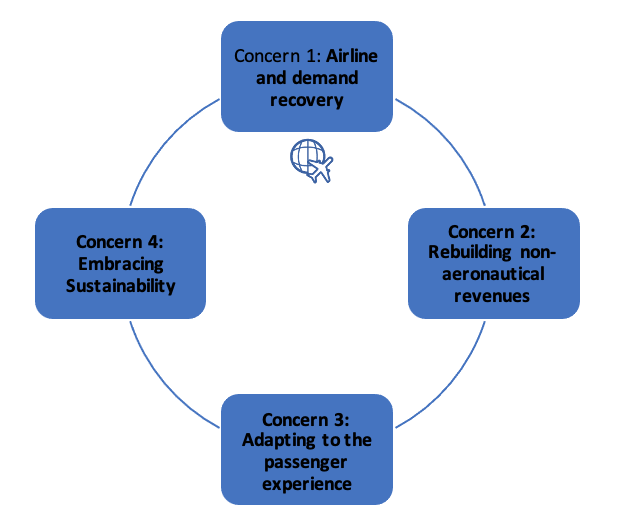
Right now, the central concern of the aviation industry is how to recover from the dramatic fall-off in traffic and revenue caused by the COVID-19 pandemic. However, this recovery is largely beyond the control of an individual airport, and will only occur once the COVID-19 pandemic is behind us. After that, airport managers will face different challenges.
At ICF*, consulting and specialist services firm, we spoke with more than two dozen C-suite airport executives across the Americas and Europe about their biggest concerns in a post-pandemic world, and about what they are doing to succeed in the new global environment.
In this article Carlos Ozores, Vice President and Managing Director of Aviation at ICF, and Stephen Freibrun, Principal Airports and Americas Sector Lead at ICF, present and discuss the key concerns among C-suite airport executives.

Concern 1: Airline and demand recovery
The COVID-19 pandemic has accelerated pre-existing trends within the airline industry and turbo-charged technological adoption in ways likely to affect how and why we travel. Adding to this, post-pandemic passenger recovery will be uneven, largely due to stark differences in vaccination rates observed throughout the world.
From the demand side, international and corporate travel may take longer to return than domestic and leisure travel. From the supply side, airlines will mostly emerge from the pandemic smaller, with a greater focus on costs and an openness to new strategies.
For airports, this means long-standing strategies need to be challenged and, in many instances, modified. Forecasting, always uncertain, will need to incorporate even greater variability, and airports will require a deeper understanding of airline financials and strategies.
“We’re focused on getting frequencies and routes back. We want to be proactive and stand out to ensure traffic returns quickly”, explains Brian Ryks, Executive and CEO of the Metropolitan Airport Commission at Minneapolis-St Paul International Airport (MSP).
We see three major trends:
1. Low-cost carriers will emerge from the pandemic in a much stronger competitive position than before.
Their leaner and more variable cost structure, combined with their focus on short-haul and leisure traffic, has allowed them to weather this period of reduced and highly volatile demand better than full-service carriers.
While the latter have also been working to cut costs, higher debt loads and obligations from government bailouts will further hamper their ability to compete. In addition, full-service carriers are more dependent on business and international travel segments, which will take longer to recover.
2. A major shift in passenger segmentation.
It is all but certain the international travel recovery will lag due to differences in vaccination rates and uncertainty over border entry requirements. Some international markets will recover sooner than others, so the impact will be uneven.
As for business travel, it would be naïve to think companies will revert to past behavior given how effective virtual work arrangements have turned out. While it is sensible to expect technology to replace lower-value business trips such as internal company travel, increased telecommuting arrangements, and more dispersed teams may drive more travel. Nevertheless, we expect business travel to take time to recover to pre-pandemic levels.
3. Airline industry competitiveness distorted by government bailouts.
Aviation remains one of the most fragmented global industries, resulting in low return on capital. In an environment of reduced demand and increased cost pressures, we would expect capacity to rationalize.
However, while the pandemic has brought airline downsizing, restructuring and once unthinkable partnerships, the combination of unprecedented government aid and availability of cheap capital and aircraft to fuel start-ups will set back much-needed industry consolidation.
This points to an era of heightened competitiveness and reduced profitability as many airlines chase after a shrunken demand pie.
Concern 2: Rebuilding non-aeronautical revenues
With international travel taking longer to recover, and with an uncertain return of business passengers, airports will miss two key demand segments that represent a disproportionately high share of revenues, whether due to the higher aeronautical tariffs (the norm outside of the United States) or spend on duty-free.
A prolonged confinement that has altered consumer behavior will further compound this problem, shifting needs and expectations in ways we cannot yet fully grasp.
Nevertheless, the changing consumer behavior and the adoption of new technologies create an opportunity for airports to reimagine the future of non-aeronautical revenues: one that leverages digital transformation and is less dependent on passenger traffic.
Airports need to understand these changes to position their commercial programs to satisfy new customer requirements, all while seeking ways to diversify their revenue sources.
We see two major priorities
1. Adapt to the changing passenger spending patterns transforming traditional retail.
The mindset of airports as passive observers of passengers transiting through their facilities needs to be rethought, with a shift toward a customer-centric approach that puts the passenger first in every way. The best practice concept of building a “sense of place” to drive increased traveler spend is not new; however, passengers will increasingly seek a personalized and memorable experience that can be delivered safely and seamlessly.
There are various emerging retail trends airports can leverage, whether on-demand delivery of retail or the use of “shopping walls” that use QR-code technology. These innovative retail ideas are all technology-driven and require airports to create a “digital layer” that complements their existing physical commercial space.
2. Revisit options to generate non-passenger-related revenues.
Although airports often aspire to develop revenue sources that are independent of traffic, very few have successfully executed the “airport city” concept (essentially real estate development).
The challenge for airports is that few such businesses need to be located on-site, and there are plenty of competitively priced alternatives available to developers.
However, the COVID-19 pandemic should urge airports to identify ways to mitigate future disruptions to their revenue streams. Beyond simply leasing land, airports can also look for creative ways to create new revenue sources, such as third-party partnerships with incubators, which then allows airports to monetize the intellectual property.
Concern 3: Adapting to the passenger experience
The combination of a new focus on biosafety, an accelerated adoption of digital technologies, and changes to consumer behaviors heightens the importance of passenger experience to a frictionless travel journey and non-aeronautical revenue growth.
However, the journey to a touchless passenger experience will not be easy.
Understanding challenges from the end user’s perspective (a customer-first mentality) provides a foundation for a well-conceived implementation roadmap.
The challenges we see start with passenger confusion.
The last major overhaul of travel protocols occurred in the aftermath of the terrorist attacks of September 11, 2001 – a process that was anything but seamless. How will the industry manage the introduction of new biosafety protocols?
A closely-related challenge is passenger dwell time. How will new passenger screening processes impact the passenger journey?
Then there are challenges associated with the impending rapid and wide-scale technological adoption, namely cultural change and technological savvy, both from the perspective of airport operators and the passenger.
Airports will need to be sensitive to differing passenger needs and carefully manage this transition to a post-pandemic airport environment.
Concern 4: Embracing Sustainability
The COVID-19 pandemic has accelerated societal focus on sustainability issues, and experts widely regard environmental risk as the next big (and inevitable) challenge to the aviation industry and the broader economy.
Governments, investors, and citizens are increasing the pressure on these topics, and airports need to do their part to address financial, reputational, and operational risks.
Greenhouse gas reduction initiatives targeting airlines are accelerating in Europe (for example, by linking airline aid packages to green initiatives) and coming to America (for example, the Biden administration’s climate and environmental justice agenda).
Prior to the COVID-19 pandemic, there was growing societal pressure for climate action—such as the “flight shaming” movement—that is certain to resume as air traffic recovers, and that has already influenced consumers, policymakers, and airlines.
Considering this, we increasingly see shareholders and investors incorporating and scrutinizing sustainability metrics into their assessments of business risk.
Sustainability also provides organizations across the aviation value chain with an opportunity to strengthen their social license and community ties by supporting sustainability measures that advocate for the environment and social equality.
Pressure to change
The COVID-19 pandemic is disrupting every industry, and airport operations are no exception.
Changing passenger behavior, a restructuring airline and supplier landscape, accelerating digital transformation, and calls to address sustainability are examples of the external pressures that airports face.
In an uncertain future, one thing remains certain: these pressures will drive major changes to how airport executives run airports in the future. And how you manage that change could be the key to industry survival.





Facebook comments